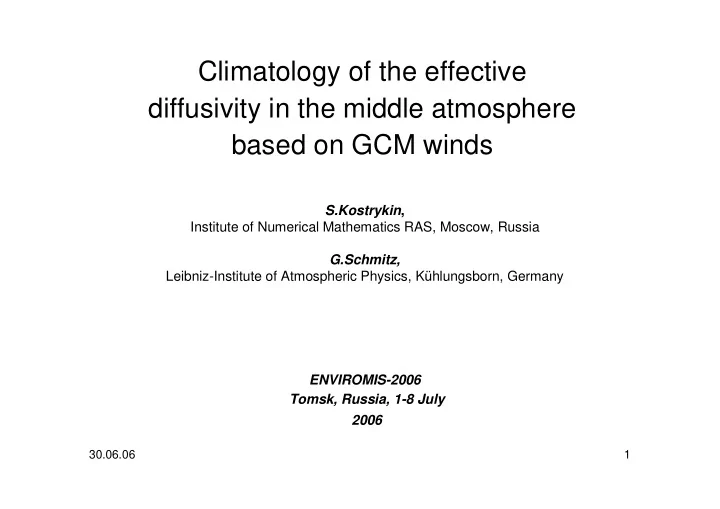

Climatology of the effective diffusivity in the middle atmosphere based on GCM winds S.Kostrykin , Institute of Numerical Mathematics RAS, Moscow, Russia G.Schmitz, Leibniz-Institute of Atmospheric Physics, K ü hlungsborn, Germany ENVIROMIS-2006 Tomsk, Russia, 1-8 July 2006 30.06.06 1
Main factors for the gas distribution in the stratosphere spacial distribution of stratospheric gases chemical atmospheric (photochemical) dynamics reactions << - dynamical factor is dominated t t adv chem << t t - chemical factor is dominated chem adv • long-lived chemical species: N 2 O, H 2 O, CH 4 , O 3 30.06.06 2
How to characterize average tracer mixing? 30.06.06 3
Definition of the effective diffusivity through Lagrangian contours Nakamura, JAS, 52, 1995 1) 2D-isentropic non-divergent motion (neglecting diabatic circulation) 2) Passive tracer (long-lived chemical component) Eulerian framework (point) Tracer induced framework (contour) ∂ ∂ ∂ q q dq = κ = κ ∆ q ∂ ∂ ∂ eff t A A dt 30.06.06 4
Definition of the effective diffusivity through Lagrangian contours Average diffusive flux: 1 ∫ ∇ r = − κ F d q n dl analogy with L NP 0 definition of usual diffusivity Effective diffusivity: r n 2 F L κ ≡ − = κ r d e F ∂ eff 1 d q L 0 = π cos ϕ 0 2 L r ∂ ϕ e r e 1 ≥ ≥ ∫ ∫ = ∇ ⋅ L e L L 2 Equivalent length: | | , L e q dl dl 0 ∇ | | q 30.06.06 5
Advection-diffusion problem • realistic winds from INM middle atmospheric climate model with horizontal resolution - 5x4° and time step – 3 hour • integration on the 21 isentropic levels from 400K up to 5000K with resolution 1x0.8° • initial distribution of tracer – zonally symmetric, linear with latitude • period of integration 6 years • no explicit diffusion is used, therefore the source of diffusion is only numerical scheme 30.06.06 6
Comparison of the model winds with UARS data 30.06.06 7
The numerical advection scheme CIP – cubic interpolated profile scheme • development - Yabe et al., 1991 • more stable modification - Kostrykin, 2001 • semi-Lagrangian, 3d-order in space for exact trajectories • stable for flows with Lipshitz number less than 1, or d u τ < max || || 1 Ω d x where τ − time step, u – wind field, Ω – integration area • conserves following the particle trajectory values of function and its gradient • to achieve an exact conservation of mass and monotonicity the special correcting procedures are applied. 30.06.06 8
Climatology of the effective diffusivity eff = κ ξ = L e ln 2 ln κ L 0 num 30.06.06 9
Climatology of the effective diffusivity Lower stratosphere Middle stratosphere eff = κ ξ = L e ln 2 ln κ L 0 num Lower mesosphere Upper stratosphere 30.06.06 10
Ozone zonal waves observed by POAM II colour - 100[χ(λ)−<χ>]/<χ>, where χ(λ) − ozone mixing ratio 55°N-65°N, <>-zonal average dots – denotes position of air parcel moving zonally with mean zonal wind ( Hoppel et all, GRL, 26, 1999 ) 30.06.06 11
Results of numerical experiments with INM GCM colour - 100(q( λ )-<q>)/<q>, where q( λ ) - tracer mixing ratio 55°N-65°N, <> - zonal average 30.06.06 12
Tracer advected by INM GCM winds 30.06.06 13
Tracer advected by INM GCM winds colour - normalized tracer mixing ratio (q-q min )/(q max -q min ) 30.06.06 14
sources of the enhanced mixing breaking waves slow waves fast waves mainly propagating from generated due to instability the troposphere of the mean flow break near critical break near critical u = = c 0 line u line 30.06.06 15
Wave-breaking and the effective diffusivity κ ln eff κ num 30.06.06 16
Wave-breaking and the effective diffusivity zero-line of the gradient of quasi-geostrophic potential vorticity wave- generating areas -line of the 30.06.06 17
Summary • discrepancies from previous analyses of the climatology of the effective diffusivity in the stratosphere can be explained by the difference in the numerical advection scheme and input GCM data • existence of the “frozen” filamentary tracer structures in the summer midlatitudes of the middle and upper stratosphere is shown •first time a climatology of the effective diffusivity in the lower mesosphere is obtained • the structure of the effective diffusivity can be explained by the wave- breaking of the planetary waves 30.06.06 18
Numerical diffusivity Evolution equation for the tracer variance ∂ 2 q 1 2 = − κ num ∇ q ∂ 2 t 30.06.06 19
Plan • Description of the effective diffusivity approach • Details of the numerical experiments and comparison of the model winds with UARS data • Climatological mean of the effective diffusivity in the stratosphere and lower mesosphere • Example of sensitivity of the effective diffusivity to the numerical advection scheme • Wave-breaking of the planetary waves and the effective diffusivity 30.06.06 20
Recommend
More recommend